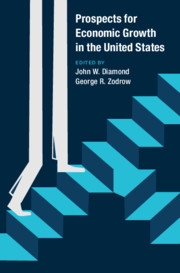Book contents
- Prospects for Economic Growth in the United States
- Prospects for Economic Growth in the United States
- Copyright page
- Dedication
- Contents
- Figures
- Tables
- Notes on Contributors
- Foreword
- Preface
- Acknowledgments
- Part I Overview
- 1 Introduction
- 2 The Future of Economic Growth in the United States
- Part II Labor and Economic Growth
- Part III Implications of Technology for Growth
- Part IV The Effects of Fiscal Policy on Growth
- Part V Special Topics on Economic Growth
- Part VI A Concluding Perspective
- Index
- References
2 - The Future of Economic Growth in the United States
from Part I - Overview
Published online by Cambridge University Press: 21 October 2021
- Prospects for Economic Growth in the United States
- Prospects for Economic Growth in the United States
- Copyright page
- Dedication
- Contents
- Figures
- Tables
- Notes on Contributors
- Foreword
- Preface
- Acknowledgments
- Part I Overview
- 1 Introduction
- 2 The Future of Economic Growth in the United States
- Part II Labor and Economic Growth
- Part III Implications of Technology for Growth
- Part IV The Effects of Fiscal Policy on Growth
- Part V Special Topics on Economic Growth
- Part VI A Concluding Perspective
- Index
- References
Summary
The US economy has grown more rapidly than other major industrial countries for many years. Looking ahead, though, that rate of growth seems likely to slow. This chapter looks at how far the US growth rate exceeds that of other industrial countries and the structural reasons behind it. It suggests that the official rate of economic growth measure understates the true rise in real income because: (i) the basic measure of money income ignores fringe benefits and the impact of taxes and transfers; and (ii) the official measure of real output growth fails to capture the contribution of quality change and new products. The main reason why the pace of US growth as officially measured is likely to decline in the next few years is that there is so much fiscal deficit and national debt; these will continue to grow rapidly unless there is significant legislative reform. The chapter goes on to discuss how revenue could be raised without taxing households and businesses in ways that discourage output. And, since the rising Social Security cost is a major part of the increase in deficit and debt, the chapter also discusses the reason for this cost increase and potential future reforms.
Keywords
- Type
- Chapter
- Information
- Prospects for Economic Growth in the United States , pp. 22 - 38Publisher: Cambridge University PressPrint publication year: 2021

